Undertaker Biography
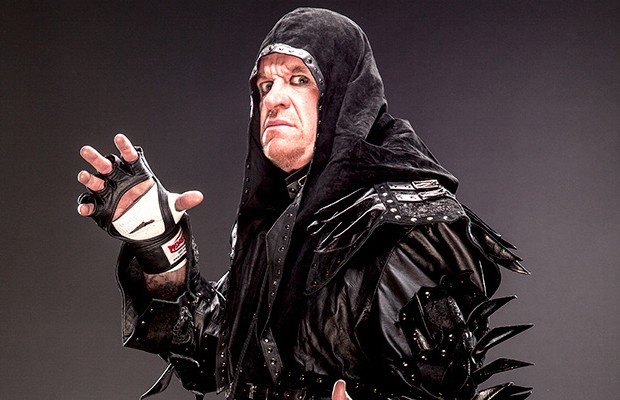
From darkness, he emerged to build a dynasty second to none. He is the “Deadman.” He is the “Lord of Darkness.” He is The Undertaker. The mysterious Superstar from Death Valley was unveiled to WWE audiences at the 1990 Survivor Series. Over the next two decades, the “Deadman’s” domination in the ring led to multiple World Championships, as well as a 22-1 record at WrestleMania.
Early Career | World Championship Wrestling (WCW) | Deadman Walking | Two Undertakers | Family Ties | A Fresh Start | The Deadman Returns | The Streak Put In Jeopardy | The End Of An Era
Early Career
The Undertaker knows all about paying his dues, and that work ethic is evident in his ring work to this day. Back in the mid-1980s, before the era of slick developmental programs, entering the professional wrestling industry could be a major hassle, a matter of dealing with shady con men and rough characters just to catch a break.
It was no different for Mark Calaway. In Bodyslams!: Memoirs of a Wrestling Pitchman, longtime ring announcer Gary Michael Cappetta, a friend of Calaway’s during the early years, shares the story of how Calaway—who had just graduated from Waltrip High School in Houston, Texas—borrowed $2,000 from his brother in order to attend Buzz Sawyer’s training school (at the recommendation of Len “The Grappler” Denton). Sawyer, according to Cappetta, skipped town with all the trainees’ money, and Calaway learned his first valuable lesson in the wrestling business. A few years later, both individuals wound up in World Championship Wrestling (WCW) at the same time and Calaway had it in his head to pound Sawyer’s face in, but was ultimately talked out of it.
He then contacted World Class Championship Wrestling (WCCW) promoter Fritz Von Erich, who referred him to Don Jardine, otherwise known as The Spoiler. Jardine encouraged Calaway to incorporate agility and high-impact moves into his repertoire, instead of relying simply on his size. The Undertaker’s old-school walk along the top rope is a tribute to the late Jardine. Calaway then signed on with World Class, where—as the masked Texas Red—Bruiser Brody beat him up in his debut match. Calaway realized that Brody was doing him a favor by teaching him respect for the business. It seemed that Brody set himself as a role model for Calaway, who would later draw comparisons with the Albuquerque wildman not only in terms of size, but ring style and mystique. Even the Texas Red persona was patterned after Brody’s masked alter-ego, Red River Jack.
Here’s an interesting side note about his debut: Texas Red was managed by Percival Pringle III, who would later become known as Paul Bearer.
As Texas Red, Calaway was briefly affiliated with Pringle, alongside such stablemates as Rick Rude, The Dingo Warrior (who would later be known as Ultimate Warrior), Cactus Jack Manson (also known as Mick Foley), and strongman Ted Arcidi. In the spring of 1987, Red recognized a golden opportunity when World Class officials announced that the promotion would be resurrecting the Texas Tag Team Championship, which had been vacant since Chris Adams and Gino Hernandez had abandoned it in 1985.
Red joined forces with Arcidi, who was most famous for his brief run in the World Wrestling Federation and appearance in the WWF and NFL Battle Royal at WrestleMania 2, to defeat his two mentors, Brody and Spoiler, in the opening round of the tournament. If that win wasn’t impressive enough, they went on to defeat the ultra-popular Fantastics—Bobby Fulton and Tommy Rogers—in the semifinals.
On the other side of the bracketing, Tony Atlas and Skip Young had overcome Brian Adias and Al Perez in the opening round, and defeated Killer Brooks and Len Denton in the second round. In the end, the combined experience of Atlas and Young paid off, and they beat Red and Arcidi in the tournament final on June 29, 1987 in Fort Worth, Texas.
During these early years with World Class, Calaway also had been attending Angelina College in Lufkin, Texas, on a basketball scholarship, and went on to Texas Wesleyan University in Fort Worth, where he played basketball and studied sports management.
By 1988, Calaway was able to pursue wrestling full-time. While Calaway had been fortunate to compete in World Class during its boom period, which included an overseas tour to South Africa, he was anxious to experiment with new identities. After a few appearances as The Commando in Central Illinois Wrestling, he was ready for the big break that was about to come in Memphis, Tennessee.
Bookers in United States Wrestling Association saw dollar signs in the 6’8″ frame of young Mark Calaway, and they gave him a big push from the very start. As The Master of Pain, Calaway had a series of managers, including Dutch Mantel, Downtown Bruno, and Ronnie Gossett. He was portrayed as an unstoppable monster, and he rode that momentum to a USWA Unified World Heavyweight Championship victory over Jerry “The King” Lawler.
Unfortunately, the continuing fallout from the Unification Match between AWA World Heavyweight Champion Jerry “The King” Lawler and WCWA World Heavyweight Champion Kerry Von Erich in December 1988 overshadowed The Master of Pain’s title reign. Lawler had won that match on a technicality, and Lawler and Von Erich were still bickering over who was the rightful unified champion—even while The Master of Pain held the belt. When Lawler regained the title on April 25, 1989, The Master of Pain faded from the main-event scene.
The Master of Pain scored a big victory in Lawler and Jerry Jarrett’s Championship Wrestling Association, defeating “Dirty” Dutch Mantell in a Loser Leaves Town Match. Texas Dirt, a masked man widely believed to be be Mantel, appeared on the scene and challenged The Master of Pain to another Loser Leaves Town Match. The Master of Pain lost this time around, and he was forced to leave the promotion.
It was back in Texas, where Calaway donned the hood as The Punisher, a member of General Skandor Akbar’s Devastation Inc. The Punisher won the WCWA Texas Heavyweight Championship by forfeit from Eric Embry on October 5, 1989, but lost it to Kerry Von Erich two weeks later.
Deadman Walking
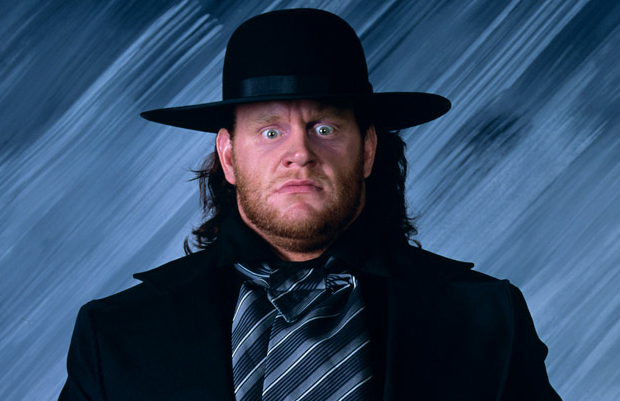
The first chapter in Undertaker’s remarkable WrestleMania epic was penned on March 24, 1991 in Los Angeles, California. Under the tutelage of new manager Paul Bearer, the “Phenom” destroyed “Superfly” Jimmy Snuka. The victory marked his first WrestleMania win, and also catapulted the “Deadman” straight to main-event status.
Undertaker spent the next several months using caskets and the mysteriously powerful urn to exploit his opponents’ fear of their own mortality. He tore through every WWF Superstar put in his path and on November 27, 1991 at the Joe Louis Arena in Detroit, Michigan, at the Survivor Series, he defeated Hulk Hogan to capture the WWF Championship. Ric Flair’s interference in The Undertaker’s WWF Championship victory ultimately caused President Jack Tunney to order a rematch at This Tuesday in Texas. Hogan wound up walking away from the event with the WWF Championship, but the controversial conclusion to the match caused Tunney to later vacate the title.
Following his WWF Championship reign, Undertaker faced a series of colossal competitors looking to rid the World Wrestling Federation of the “Deadman.” The four-hundred pound “Ugandan Giant” Kamala nearly accomplished the task during the first-ever Coffin Match at the 1992 Survivor Series. Undertaker was able to avoid Kamala’s offensive onslaught en route to picking up the ground-breaking victory. The following year, the “Phenom” toppled the near eight-foot Giant Gonzales at WrestleMania IX.
Two Undertakers
Many believed Undertaker had finally met his match when he squared off against WWF Champion Yokozuna at the 1994 Royal Rumble. The encounter saw Undertaker victimized by not only the mighty Yokozuna, but a posse of oversized wrestlers, including Bam Bam Bigelow and Diesel. Many assumed the defeat, which saw Undertaker stuffed into a ringside casket, meant the demise of the “Deadman.” However, as Yokozuna’s gang pushed the casket up the aisle, an eerie smoke began to fill the arena, followed by the familiar gong of Undertaker’s entrance theme. “The Deadman” then appeared on the Titantron to proclaim, “I will not rest in peace.”
Both “The Million Dollar Man” Ted DiBiase and Paul Bearer claimed to have found Undertaker in the summer of 1994. The two men agreed to have their Undertakers square off against each other at SummerSlam. In the end, Bearer’s Undertaker proved to be the real “Phenom,” defeating DiBiase’s fake after striking him with three Tombstone Piledrivers.
Undertaker’s disappearance in 1994 caused him to miss WrestleMania X, but his darkness dominance returned the following year when he defeated the massive King Kong Bundy in Hartford, Connecticut. The following year, he handily defeated Diesel.
Following his defeat of Diesel, Undertaker became the target of World Wrestling Federation newcomer Mankind. Their intense rivalry sparked the advent of two revolutionary match types, the Boiler Room Brawl and Buried Alive Match. It also marked the shocking end to one of the closet alliances of all-time when Paul Bearer clobbered Undertaker with his urn at the 1996 SummerSlam.
Despite losing his manager Mankind, Undertaker continued to post an impressive record, which earned him a WWF Championship opportunity against Sycho Sid at WrestleMania 13.
Following a skull-crushing Tombstone, the “Phenom” covered Sid to reclaim the title he lost more than five years earlier. The victory catapulted Undertaker back to the top of the professional wrestling world. He spent the next five months successfully defending the title against the likes of “Stone Cold” Steve Austin and Vader.
Family Ties
An errant steel chair shot at the hands of special referee Shawn Michaels allowed Bret “Hit Man” Hart to dethrone Undertaker at SummerSlam in 1997. Yearning for revenge, the “Deadman” shifted his focus from the WWF Championship scene to destroying HBK. After a series of inconclusive contests, the two wrestlers agreed to settle the score in the first-ever Hell in a Cell Match at Badd Blood. Once locked inside the satanic structure, Undertaker released all his frustrations on Michaels, but just when it appeared as though victory was certain, Undertaker came face to face with a familiar figure from the past that cost him the match: Kane.
In the months leading up to Kane’s shocking debut, Paul Bearer, in an attempt to blackmail Undertaker, threatened to uncover a disturbing secret from the “Deadman’s” past. When Undertaker refused to give in to the demands, Bearer finally revealed that the “Phenom” set fire to his family’s funeral parlor twenty years earlier, killing his mother and father. Undertaker assumed his younger brother also perished in the fire. At Badd Blood, Undertaker’s assumption proved to be dead wrong, as his disfigured sibling appeared from out of nowhere to attack him.
In the months following the shocking revelation, Undertaker refused to step in the ring with his flesh and blood. However, after Kane attempted to send him to a fiery grave at the 1998 Royal Rumble, Undertaker had no choice but to respond with force. The two brothers finally squared off at WrestleMania XIV. Undertaker won the emotional battle, but the war between the two was just heating up. Undertaker and Kane went on to engage in some of the most bitter battles ever seen, including two Inferno Matches.
In 1998, Undertaker adopted an even darker, more demonic demeanor. He also made the unpopular decision to reconcile with Paul Bearer to form the Ministry of Darkness. Claiming to serve a “higher power,” Undertaker unleashed a never-before-seen assault on the entire World Wrestling Federation. Nobody was safe from Undertaker’s wicked wrath, not even Vince McMahon’s daughter Stephanie, who was abducted by the “Deadman.” Luckily for Stephanie, “Stone Cold” Steve Austin rescued her from further torment. The heroics, however, landed Austin in WWF Championship defense against Undertaker the following month at Over the Edge.
A Fresh Start
Leaving his “Deadman” persona in the dust, Undertaker reemerged at Judgment Day riding a motorcycle. Recognized as the “American Bad Ass,” the new Undertaker was equally imposing. Following an impressive victory over Triple H at WrestleMania X-Seven, Undertaker formed an alliance with Kane. Known as the Brothers of Destruction, the duo spent the next several months dominating the tag team scene.
More than a decade after defeating Hulk Hogan for his first WWE Championship, Undertaker challenged the Hulkster for the same prize at Judgment Day in 2002. Much like that fateful night back in 1991, he used a steel chair to claim the title from Hogan.
The fiery family hostility between Undertaker and Kane reignited in late 2003. This time, however, Kane appeared to walk away the victory when he assisted Mr. McMahon in burying his brother alive at Survivor Series. As mounds of dirt covered Undertaker’s seemingly lifeless body, many assumed they had finally seen the end of Undertaker.
The Deadman Returns
Proving you can’t kill what’s already dead, Undertaker made his triumph return to WWE at WrestleMania XX. He defeated Kane to improve his WrestleMania record to an astonishing 12-0. The “Phenom’s” iconic status made him the perfect target for the brash youngster Randy Orton. The third-generation grappler saw Undertaker’s ageless WrestleMania record as an opportunity to permanently etch his name into the WWE history books. Unfortunately for the self-appointed “Legend Killer,” he became unlucky victor number thirteen.
By 2007, there were two glaring holes on the Undertaker’s impressive resume. He had never won a Royal Rumble or captured the World Heavyweight Championship. In January 2007, he filled in one hole when he last eliminated Shawn Michaels to win the Royal Rumble. Winning that match allowed him to meet Batista at WrestleMania 23 for the World Heavyweight Championship, which he won after a Tombstone Piledriver. Undertaker duplicated his efforts the following year when he toppled Edge at WrestleMania XXIV to become a two-time World Heavyweight Champion.
His time with the title was cut short when Vickie Guerrero declared Undertaker’s submission hold, Hell’s Gate, illegal. Edge won the match with an assist from La Familia, which resulted in Undertaker being forced out of WWE. Fortunately for fans, Edge and Vickie had a bitter falling out, resulting in Vickie reinstituting Undertaker two months later.
The Streak Put In Jeopardy
Over the course of sixteen WrestleMania appearances, Undertaker had never tasted defeat. However, Shawn Michaels claimed Undertaker had never defeated him in a singles match and demanded a shot at WrestleMania XXV. In what is widely considered one of the most epic matches in WWE history, Undertaker won the encounter to boost his record to 17-0, then went on to claim the World Heavyweight Championship from CM Punk later in the year. Undertaker defended the title against Punk and Batista but lost it to Chris Jericho when Michaels, demanding a second chance at Undertaker’s undefeated streak at WrestleMania, interfered in the match. Undertaker ultimately agreed to the match, but with one stipulation: if Shawn Michaels lost, he must retire. The “Career versus Streak” Match took place at WrestleMania XXVI. In the end, Undertaker put Michaels through hell and sent him into retirement.
Shortly after his victory over Michaels, Undertaker was put out of action after being attacked by an unknown assailant. Kane and Rey Mysterio each blamed each other, but the truth came to light when Undertaker returned at SummerSlam and was attacked by Kane. The two eventually met in a Buried Alive Match where Paul Bearer and the Nexus helped Kane bury Undertaker, who then wasn’t seen for months.
The End Of An Era
Hints of Undertaker’s return first appeared during the 2011 Royal Rumble. His return on February 21 was interrupted by Triple H, making his first appearance in nearly a year. Following in the footsteps of his friend, Shawn Michaels, “The Game” sought to end Underaker’s WrestleMania winning streak. The No-Holds Barred Match between two “Last Outlaws” at WrestleMania XXVII ended in victory for Undertaker, but he left the ring on a stretcher while Triple H walked out under his own power.
Undertaker vanished from WWE for the rest of 2011, returning in January 2012 to demand a rematch against an initially-reluctant Triple H. The two met at WrestleMania XXVIII in a Hell in a Cell Match refereed by Shawn Michaels. The brutal encounter left both men bloodied and battered, but in the end Undertaker claimed victory and pushed his streak to 20-0. When it came time to leave the ring, all three men supported each other and walked into the night, together, symbolizing the “End of an Era.”

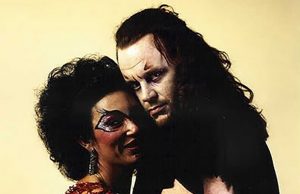
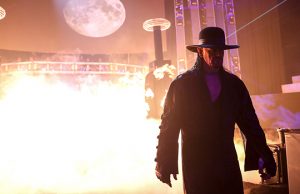
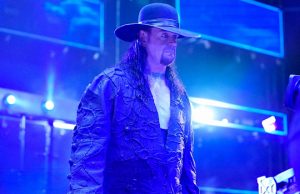











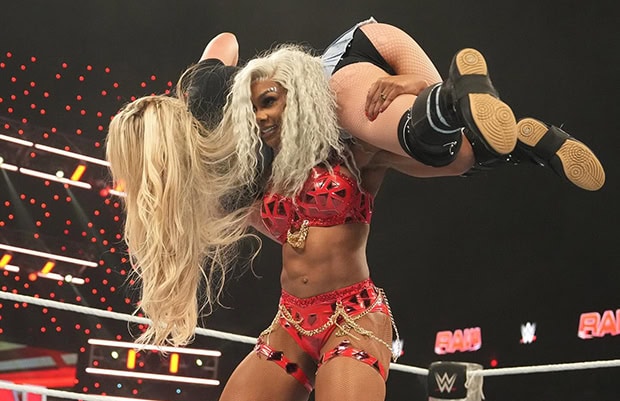
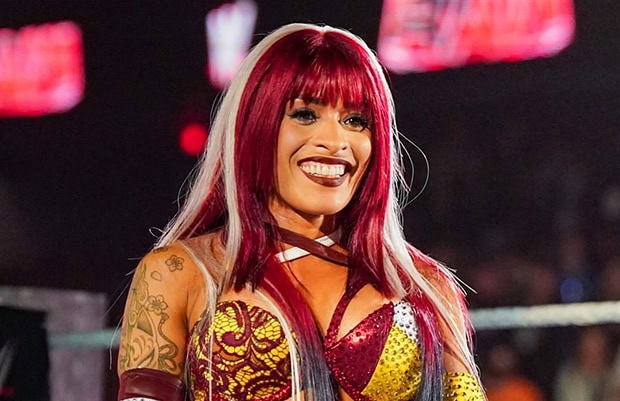
0 comments